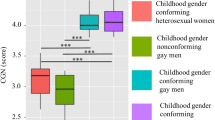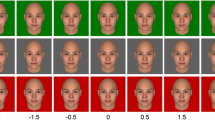Abstract
Human observers adapted to complex biological motions that distinguish males from females: viewing the gait of one gender biased judgments of subsequent gaits toward the opposite gender. This adaptation was not simply due to local features of the stimuli but instead relied upon the global motion of the figures. These results suggest the existence of neurons selective for gender and demonstrate that gender-from-motion judgments are not fixed but depend upon recent viewing history.
This is a preview of subscription content, access via your institution
Access options
Subscribe to this journal
Receive 12 print issues and online access
$209.00 per year
only $17.42 per issue
Buy this article
- Purchase on Springer Link
- Instant access to full article PDF
Prices may be subject to local taxes which are calculated during checkout

Similar content being viewed by others
References
Barlow, H.B. & Hill, R.M. Nature 200, 1345–1347 (1963).
Levinson, E. & Sekuler, R. Vision Res. 16, 779–781 (1976).
Blakemore, C. & Campbell, F.W. J. Physiol. (Lond.) 203, 237–260 (1969).
Leopold, D.A., O'Toole, A.J., Vetter, T. & Blanz, V. Nat. Neurosci. 4, 89–94 (2001).
Webster, M.A., Kaping, D., Mizokami, Y. & Duhamel, P. Nature 428, 557–561 (2004).
Gross, C.G., Bender, D.B. & Rocha-Miranda, C.E. Science 166, 1303–1306 (1969).
Desimone, R., Albright, T.D., Gross, C.G. & Bruce, C. J. Neurosci. 4, 2051–2062 (1984).
Kozlowski, L.T. & Cutting, J.E. Percept. Psychophys. 21, 575–580 (1977).
Barclay, C.D., Cutting, J.E. & Kozlowski, L.T. Percept. Psychophys. 23, 145–152 (1978).
Johansson, G. Percept. Psychophys. 14, 201–211 (1973).
Mather, G. & Murdoch, L. Proc. R. Soc. Lond. B Biol. Sci. 258, 273–279 (1994).
Sergent, J., Ohta, S. & McDonald, B. Brain 115, 15–36 (1992).
McCollough, C. Science 149, 1115–1116 (1965).
Engel, S.A. Neuron 45, 613–623 (2005).
Grill-Spector, K. et al. Neuron 24, 187–203 (1999).
Acknowledgements
We thank B. Krekelberg and J. Reynolds for their useful comments. This research was supported by the National Institute of Mental Health (grant 5T32MH020002-05 to H.J.) and the National Eye Institute (grant 2RO1EY12872-05 to G.R.S.).
Author information
Authors and Affiliations
Contributions
H.J. designed and conducted the experiment, constructed the stimuli, analyzed the data and contributed to discussions and writing the manuscript. M.F. contributed to discussions and writing the manuscript. G.R.S. had the original experimental idea, contributed to discussions and writing the manuscript.
Corresponding author
Ethics declarations
Competing interests
The authors declare no competing financial interests.
Supplementary information
Supplementary Video 1
Examples of the coherent adapting PLWer stimuli used in both experiment 1 and 2, showing the female (left), neutral (center) and male (right) stimuli (MOV 518 kb)
Supplementary Video 2
Two examples of the test stimuli are shown here, namely the extreme ends of the test stimuli range (.64/.36 female/male & .36/.64 female/male). (MOV 694 kb)
Supplementary Video 3
Examples of the dephased adapting PLWer stimuli used in experiment 2, showing the female (left), neutral (center) and male (right) stimuli. (MOV 735 kb)
Rights and permissions
About this article
Cite this article
Jordan, H., Fallah, M. & Stoner, G. Adaptation of gender derived from biological motion. Nat Neurosci 9, 738–739 (2006). https://doi.org/10.1038/nn1710
Received:
Accepted:
Published:
Issue Date:
DOI: https://doi.org/10.1038/nn1710
This article is cited by
-
Adaptation to the Speed of Biological Motion in Autism
Journal of Autism and Developmental Disorders (2020)
-
Sex discriminations made on the basis of ambiguous visual cues can be affected by the presence of an olfactory cue
BMC Psychology (2013)
-
Gender bending: auditory cues affect visual judgements of gender in biological motion displays
Experimental Brain Research (2009)



